Christ University MBA: Financial Econometric Analysis of BSE Sensex
VerifiedAdded on 2022/01/25
|25
|6485
|20
Report
AI Summary
This report, submitted by Vedika Chokhani as part of the MBA Programme at Christ (Deemed to be University), Bengaluru, in September 2021, investigates the relationship between exchange rates, inflation, and the performance of the BSE Sensex. The introduction provides an overview of the stock market, its functions, and the role of the BSE as a major stock exchange. The report delves into the objectives of stock exchanges, market indexes like Sensex and Nifty, and factors affecting stock prices, including economic and political factors, natural calamities, and investor sentiment. It also defines and explains the impact of inflation and foreign exchange rates on the stock market. The report aims to provide a financial econometric analysis of how these macroeconomic variables influence the BSE Sensex, contributing to a broader understanding of market dynamics and investment strategies. The report is a comprehensive financial analysis of the Bombay Stock Exchange and the factors affecting its performance.
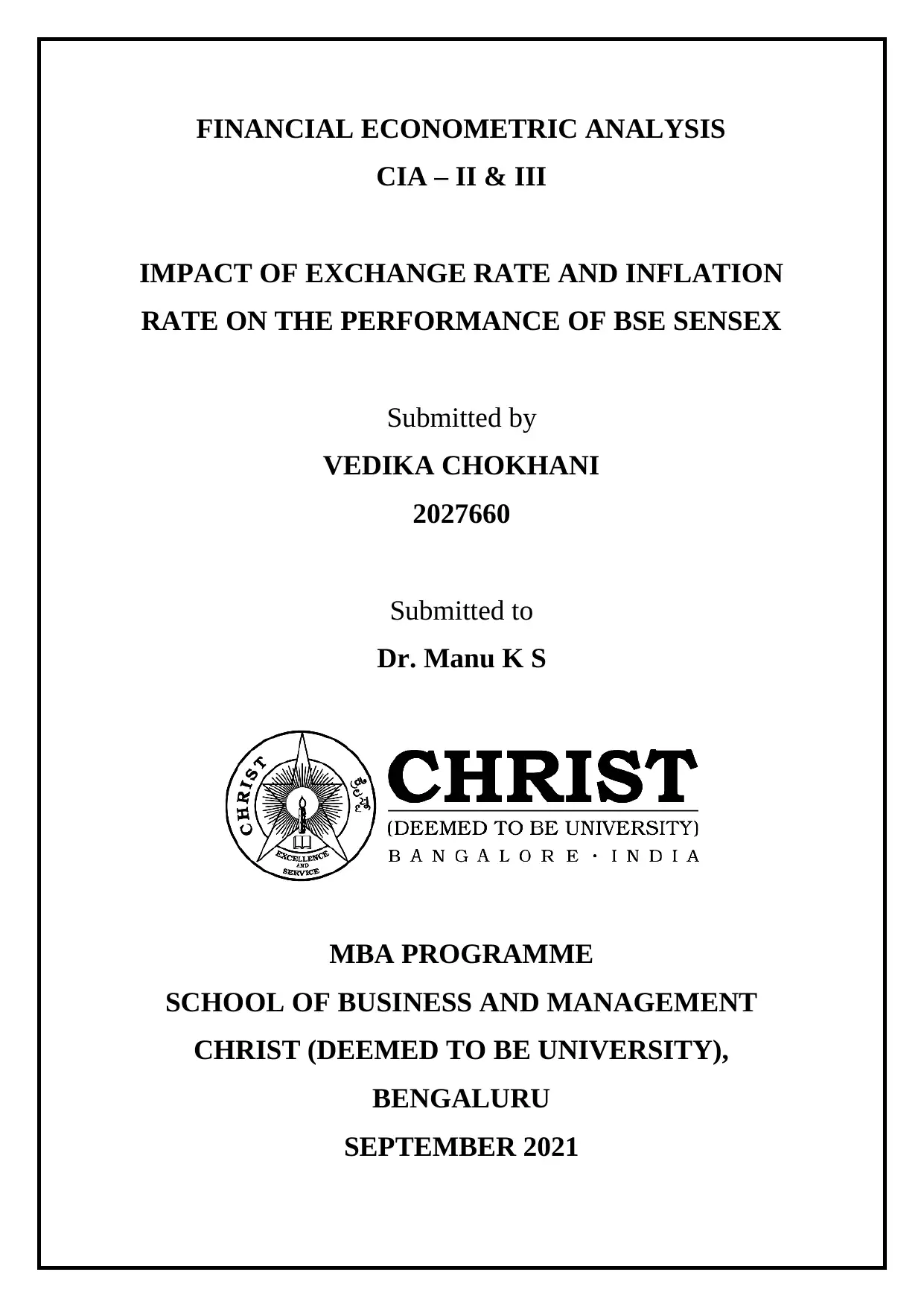
FINANCIAL ECONOMETRIC ANALYSIS
CIA – II & III
IMPACT OF EXCHANGE RATE AND INFLATION
RATE ON THE PERFORMANCE OF BSE SENSEX
Submitted by
VEDIKA CHOKHANI
2027660
Submitted to
Dr. Manu K S
MBA PROGRAMME
SCHOOL OF BUSINESS AND MANAGEMENT
CHRIST (DEEMED TO BE UNIVERSITY),
BENGALURU
SEPTEMBER 2021
CIA – II & III
IMPACT OF EXCHANGE RATE AND INFLATION
RATE ON THE PERFORMANCE OF BSE SENSEX
Submitted by
VEDIKA CHOKHANI
2027660
Submitted to
Dr. Manu K S
MBA PROGRAMME
SCHOOL OF BUSINESS AND MANAGEMENT
CHRIST (DEEMED TO BE UNIVERSITY),
BENGALURU
SEPTEMBER 2021
Paraphrase This Document
Need a fresh take? Get an instant paraphrase of this document with our AI Paraphraser
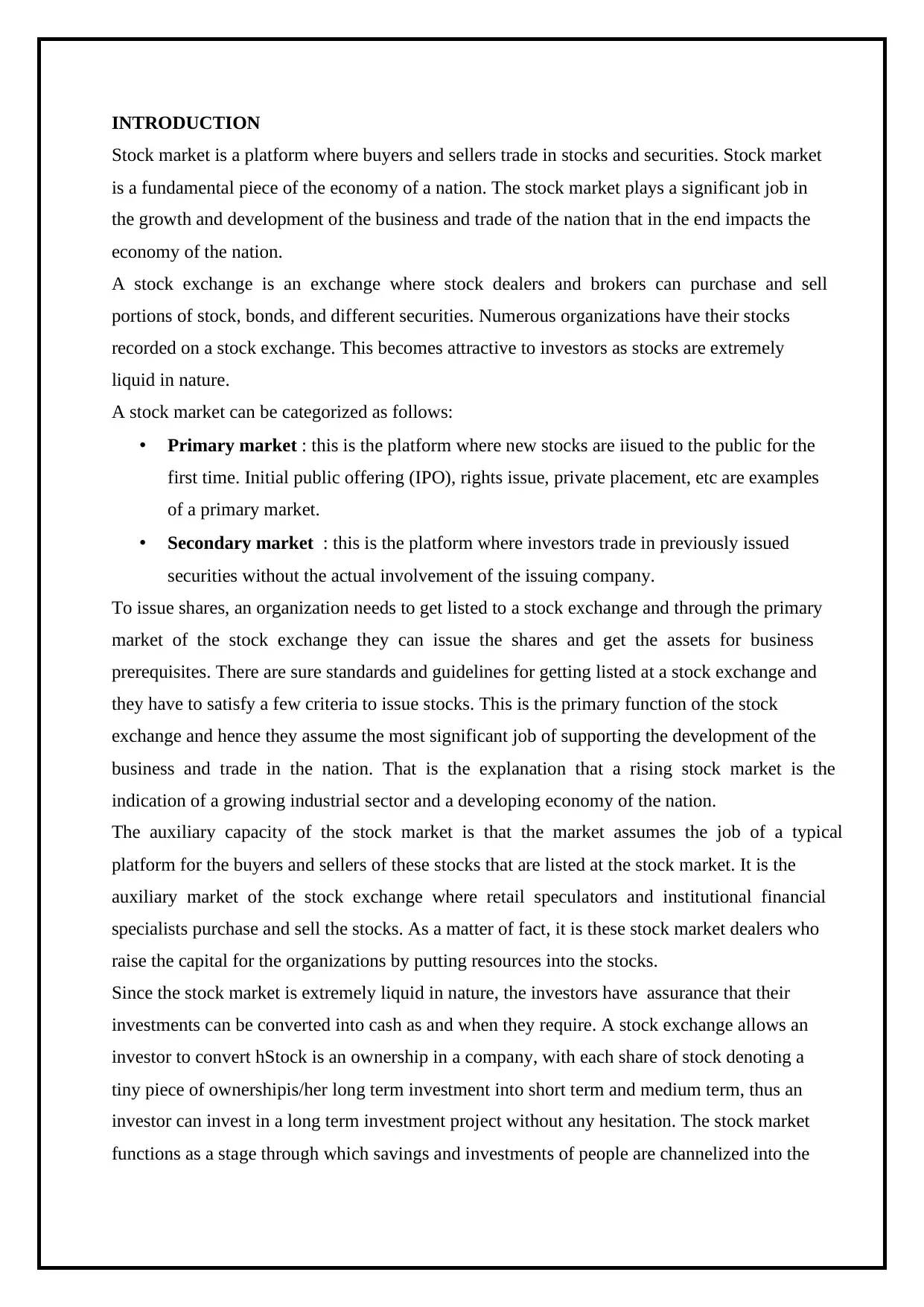
INTRODUCTION
Stock market is a platform where buyers and sellers trade in stocks and securities. Stock market
is a fundamental piece of the economy of a nation. The stock market plays a significant job in
the growth and development of the business and trade of the nation that in the end impacts the
economy of the nation.
A stock exchange is an exchange where stock dealers and brokers can purchase and sell
portions of stock, bonds, and different securities. Numerous organizations have their stocks
recorded on a stock exchange. This becomes attractive to investors as stocks are extremely
liquid in nature.
A stock market can be categorized as follows:
• Primary market : this is the platform where new stocks are iisued to the public for the
first time. Initial public offering (IPO), rights issue, private placement, etc are examples
of a primary market.
• Secondary market : this is the platform where investors trade in previously issued
securities without the actual involvement of the issuing company.
To issue shares, an organization needs to get listed to a stock exchange and through the primary
market of the stock exchange they can issue the shares and get the assets for business
prerequisites. There are sure standards and guidelines for getting listed at a stock exchange and
they have to satisfy a few criteria to issue stocks. This is the primary function of the stock
exchange and hence they assume the most significant job of supporting the development of the
business and trade in the nation. That is the explanation that a rising stock market is the
indication of a growing industrial sector and a developing economy of the nation.
The auxiliary capacity of the stock market is that the market assumes the job of a typical
platform for the buyers and sellers of these stocks that are listed at the stock market. It is the
auxiliary market of the stock exchange where retail speculators and institutional financial
specialists purchase and sell the stocks. As a matter of fact, it is these stock market dealers who
raise the capital for the organizations by putting resources into the stocks.
Since the stock market is extremely liquid in nature, the investors have assurance that their
investments can be converted into cash as and when they require. A stock exchange allows an
investor to convert hStock is an ownership in a company, with each share of stock denoting a
tiny piece of ownershipis/her long term investment into short term and medium term, thus an
investor can invest in a long term investment project without any hesitation. The stock market
functions as a stage through which savings and investments of people are channelized into the
Stock market is a platform where buyers and sellers trade in stocks and securities. Stock market
is a fundamental piece of the economy of a nation. The stock market plays a significant job in
the growth and development of the business and trade of the nation that in the end impacts the
economy of the nation.
A stock exchange is an exchange where stock dealers and brokers can purchase and sell
portions of stock, bonds, and different securities. Numerous organizations have their stocks
recorded on a stock exchange. This becomes attractive to investors as stocks are extremely
liquid in nature.
A stock market can be categorized as follows:
• Primary market : this is the platform where new stocks are iisued to the public for the
first time. Initial public offering (IPO), rights issue, private placement, etc are examples
of a primary market.
• Secondary market : this is the platform where investors trade in previously issued
securities without the actual involvement of the issuing company.
To issue shares, an organization needs to get listed to a stock exchange and through the primary
market of the stock exchange they can issue the shares and get the assets for business
prerequisites. There are sure standards and guidelines for getting listed at a stock exchange and
they have to satisfy a few criteria to issue stocks. This is the primary function of the stock
exchange and hence they assume the most significant job of supporting the development of the
business and trade in the nation. That is the explanation that a rising stock market is the
indication of a growing industrial sector and a developing economy of the nation.
The auxiliary capacity of the stock market is that the market assumes the job of a typical
platform for the buyers and sellers of these stocks that are listed at the stock market. It is the
auxiliary market of the stock exchange where retail speculators and institutional financial
specialists purchase and sell the stocks. As a matter of fact, it is these stock market dealers who
raise the capital for the organizations by putting resources into the stocks.
Since the stock market is extremely liquid in nature, the investors have assurance that their
investments can be converted into cash as and when they require. A stock exchange allows an
investor to convert hStock is an ownership in a company, with each share of stock denoting a
tiny piece of ownershipis/her long term investment into short term and medium term, thus an
investor can invest in a long term investment project without any hesitation. The stock market
functions as a stage through which savings and investments of people are channelized into the

gainful speculation proposition. In the long haul, it helps in capital improvement and financial
advancement for the country.
The stock market is very dynamic and comprehensive so it is obvious that along with domestic
factors the international macro- economic factors also affect the stock market.
A stock represents a person’s ownerhip in a company. The more shares a person owns, the
more potion of the company they own. The more shares they own, the more interest they
receive when the company makes a profit. In the financial world, ownership called equity.
There are two primary classes of stock. A person chooses a particular kind of stock depending
on what they expect in return from the investment. Preferred stock generally gives out regular
dividend payments to the shareholders and this is typically chosen as an investment by those
who want a regular income. Common Stocks represent ownership of a company and it offers
more rights and privileges as compared to preferred stocks. Investors may purchase stock on
the primary or secondary markets.
FUNCTIONS OF STOCK MARKET
• Safety of funds: all the transactions taking place in the stock market are well regulated
and all participants are required to work within a legal framework. This ensures safety
of funds in the market.
• Liquidity and marketability of securities: one of the main functions of a stock market
is to provide liquidity to the investors. It is a platform where securities are continuously
traded and hence assures the investors that their investments can be converted into cash
as and when they want.
• Facilitates economic growth: in stock exchange securities of different organizations
are purchased and sold. This procedure of disinvestment and reinvestment assists with
putting resources into most beneficial investment proposition and this leads to
economic growth and development.
• Flow of capital to profitable ventures: a stock market helps in channelizing the
savings of people into profitable ventures.
• Protection to investors: as only reputable and genuine organizations are listed on the
stock exchange, the interests and funds of the investors are protected.
• Promotion of investment: a stock market encourages people to save and invest more
by providing attractive investment options.
advancement for the country.
The stock market is very dynamic and comprehensive so it is obvious that along with domestic
factors the international macro- economic factors also affect the stock market.
A stock represents a person’s ownerhip in a company. The more shares a person owns, the
more potion of the company they own. The more shares they own, the more interest they
receive when the company makes a profit. In the financial world, ownership called equity.
There are two primary classes of stock. A person chooses a particular kind of stock depending
on what they expect in return from the investment. Preferred stock generally gives out regular
dividend payments to the shareholders and this is typically chosen as an investment by those
who want a regular income. Common Stocks represent ownership of a company and it offers
more rights and privileges as compared to preferred stocks. Investors may purchase stock on
the primary or secondary markets.
FUNCTIONS OF STOCK MARKET
• Safety of funds: all the transactions taking place in the stock market are well regulated
and all participants are required to work within a legal framework. This ensures safety
of funds in the market.
• Liquidity and marketability of securities: one of the main functions of a stock market
is to provide liquidity to the investors. It is a platform where securities are continuously
traded and hence assures the investors that their investments can be converted into cash
as and when they want.
• Facilitates economic growth: in stock exchange securities of different organizations
are purchased and sold. This procedure of disinvestment and reinvestment assists with
putting resources into most beneficial investment proposition and this leads to
economic growth and development.
• Flow of capital to profitable ventures: a stock market helps in channelizing the
savings of people into profitable ventures.
• Protection to investors: as only reputable and genuine organizations are listed on the
stock exchange, the interests and funds of the investors are protected.
• Promotion of investment: a stock market encourages people to save and invest more
by providing attractive investment options.
⊘ This is a preview!⊘
Do you want full access?
Subscribe today to unlock all pages.

Trusted by 1+ million students worldwide
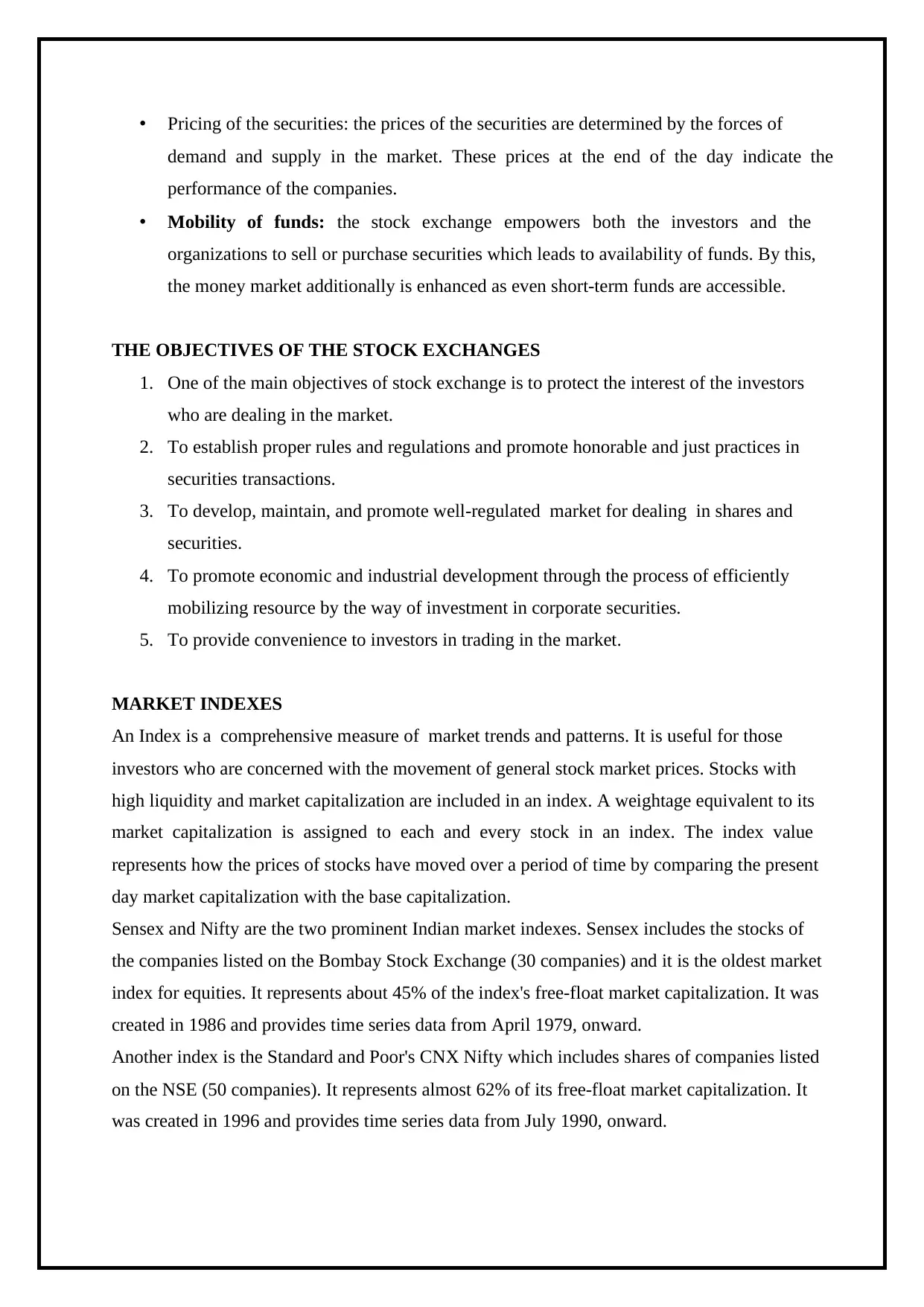
• Pricing of the securities: the prices of the securities are determined by the forces of
demand and supply in the market. These prices at the end of the day indicate the
performance of the companies.
• Mobility of funds: the stock exchange empowers both the investors and the
organizations to sell or purchase securities which leads to availability of funds. By this,
the money market additionally is enhanced as even short-term funds are accessible.
THE OBJECTIVES OF THE STOCK EXCHANGES
1. One of the main objectives of stock exchange is to protect the interest of the investors
who are dealing in the market.
2. To establish proper rules and regulations and promote honorable and just practices in
securities transactions.
3. To develop, maintain, and promote well-regulated market for dealing in shares and
securities.
4. To promote economic and industrial development through the process of efficiently
mobilizing resource by the way of investment in corporate securities.
5. To provide convenience to investors in trading in the market.
MARKET INDEXES
An Index is a comprehensive measure of market trends and patterns. It is useful for those
investors who are concerned with the movement of general stock market prices. Stocks with
high liquidity and market capitalization are included in an index. A weightage equivalent to its
market capitalization is assigned to each and every stock in an index. The index value
represents how the prices of stocks have moved over a period of time by comparing the present
day market capitalization with the base capitalization.
Sensex and Nifty are the two prominent Indian market indexes. Sensex includes the stocks of
the companies listed on the Bombay Stock Exchange (30 companies) and it is the oldest market
index for equities. It represents about 45% of the index's free-float market capitalization. It was
created in 1986 and provides time series data from April 1979, onward.
Another index is the Standard and Poor's CNX Nifty which includes shares of companies listed
on the NSE (50 companies). It represents almost 62% of its free-float market capitalization. It
was created in 1996 and provides time series data from July 1990, onward.
demand and supply in the market. These prices at the end of the day indicate the
performance of the companies.
• Mobility of funds: the stock exchange empowers both the investors and the
organizations to sell or purchase securities which leads to availability of funds. By this,
the money market additionally is enhanced as even short-term funds are accessible.
THE OBJECTIVES OF THE STOCK EXCHANGES
1. One of the main objectives of stock exchange is to protect the interest of the investors
who are dealing in the market.
2. To establish proper rules and regulations and promote honorable and just practices in
securities transactions.
3. To develop, maintain, and promote well-regulated market for dealing in shares and
securities.
4. To promote economic and industrial development through the process of efficiently
mobilizing resource by the way of investment in corporate securities.
5. To provide convenience to investors in trading in the market.
MARKET INDEXES
An Index is a comprehensive measure of market trends and patterns. It is useful for those
investors who are concerned with the movement of general stock market prices. Stocks with
high liquidity and market capitalization are included in an index. A weightage equivalent to its
market capitalization is assigned to each and every stock in an index. The index value
represents how the prices of stocks have moved over a period of time by comparing the present
day market capitalization with the base capitalization.
Sensex and Nifty are the two prominent Indian market indexes. Sensex includes the stocks of
the companies listed on the Bombay Stock Exchange (30 companies) and it is the oldest market
index for equities. It represents about 45% of the index's free-float market capitalization. It was
created in 1986 and provides time series data from April 1979, onward.
Another index is the Standard and Poor's CNX Nifty which includes shares of companies listed
on the NSE (50 companies). It represents almost 62% of its free-float market capitalization. It
was created in 1996 and provides time series data from July 1990, onward.
Paraphrase This Document
Need a fresh take? Get an instant paraphrase of this document with our AI Paraphraser
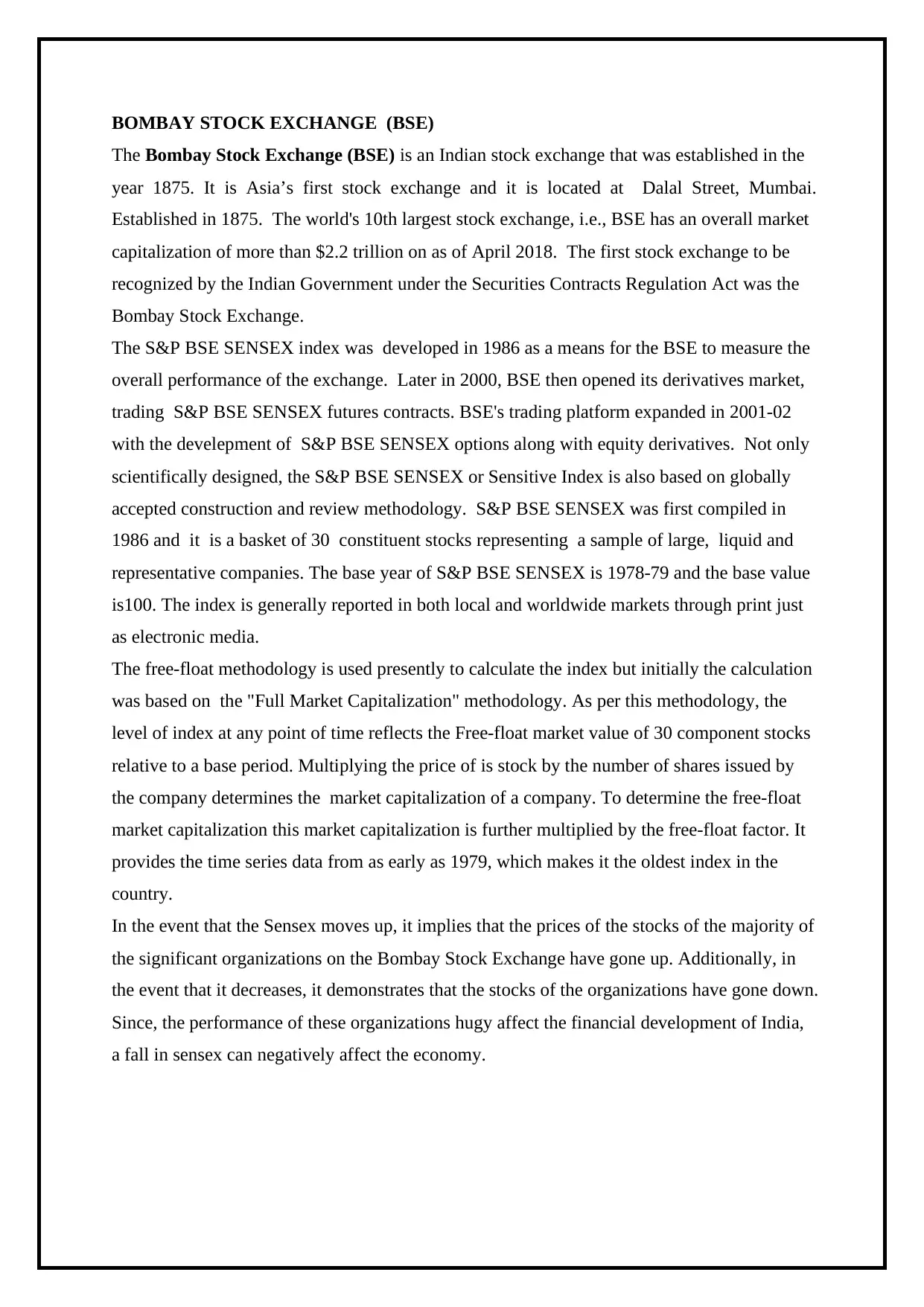
BOMBAY STOCK EXCHANGE (BSE)
The Bombay Stock Exchange (BSE) is an Indian stock exchange that was established in the
year 1875. It is Asia’s first stock exchange and it is located at Dalal Street, Mumbai.
Established in 1875. The world's 10th largest stock exchange, i.e., BSE has an overall market
capitalization of more than $2.2 trillion on as of April 2018. The first stock exchange to be
recognized by the Indian Government under the Securities Contracts Regulation Act was the
Bombay Stock Exchange.
The S&P BSE SENSEX index was developed in 1986 as a means for the BSE to measure the
overall performance of the exchange. Later in 2000, BSE then opened its derivatives market,
trading S&P BSE SENSEX futures contracts. BSE's trading platform expanded in 2001-02
with the develepment of S&P BSE SENSEX options along with equity derivatives. Not only
scientifically designed, the S&P BSE SENSEX or Sensitive Index is also based on globally
accepted construction and review methodology. S&P BSE SENSEX was first compiled in
1986 and it is a basket of 30 constituent stocks representing a sample of large, liquid and
representative companies. The base year of S&P BSE SENSEX is 1978-79 and the base value
is100. The index is generally reported in both local and worldwide markets through print just
as electronic media.
The free-float methodology is used presently to calculate the index but initially the calculation
was based on the "Full Market Capitalization" methodology. As per this methodology, the
level of index at any point of time reflects the Free-float market value of 30 component stocks
relative to a base period. Multiplying the price of is stock by the number of shares issued by
the company determines the market capitalization of a company. To determine the free-float
market capitalization this market capitalization is further multiplied by the free-float factor. It
provides the time series data from as early as 1979, which makes it the oldest index in the
country.
In the event that the Sensex moves up, it implies that the prices of the stocks of the majority of
the significant organizations on the Bombay Stock Exchange have gone up. Additionally, in
the event that it decreases, it demonstrates that the stocks of the organizations have gone down.
Since, the performance of these organizations hugy affect the financial development of India,
a fall in sensex can negatively affect the economy.
The Bombay Stock Exchange (BSE) is an Indian stock exchange that was established in the
year 1875. It is Asia’s first stock exchange and it is located at Dalal Street, Mumbai.
Established in 1875. The world's 10th largest stock exchange, i.e., BSE has an overall market
capitalization of more than $2.2 trillion on as of April 2018. The first stock exchange to be
recognized by the Indian Government under the Securities Contracts Regulation Act was the
Bombay Stock Exchange.
The S&P BSE SENSEX index was developed in 1986 as a means for the BSE to measure the
overall performance of the exchange. Later in 2000, BSE then opened its derivatives market,
trading S&P BSE SENSEX futures contracts. BSE's trading platform expanded in 2001-02
with the develepment of S&P BSE SENSEX options along with equity derivatives. Not only
scientifically designed, the S&P BSE SENSEX or Sensitive Index is also based on globally
accepted construction and review methodology. S&P BSE SENSEX was first compiled in
1986 and it is a basket of 30 constituent stocks representing a sample of large, liquid and
representative companies. The base year of S&P BSE SENSEX is 1978-79 and the base value
is100. The index is generally reported in both local and worldwide markets through print just
as electronic media.
The free-float methodology is used presently to calculate the index but initially the calculation
was based on the "Full Market Capitalization" methodology. As per this methodology, the
level of index at any point of time reflects the Free-float market value of 30 component stocks
relative to a base period. Multiplying the price of is stock by the number of shares issued by
the company determines the market capitalization of a company. To determine the free-float
market capitalization this market capitalization is further multiplied by the free-float factor. It
provides the time series data from as early as 1979, which makes it the oldest index in the
country.
In the event that the Sensex moves up, it implies that the prices of the stocks of the majority of
the significant organizations on the Bombay Stock Exchange have gone up. Additionally, in
the event that it decreases, it demonstrates that the stocks of the organizations have gone down.
Since, the performance of these organizations hugy affect the financial development of India,
a fall in sensex can negatively affect the economy.
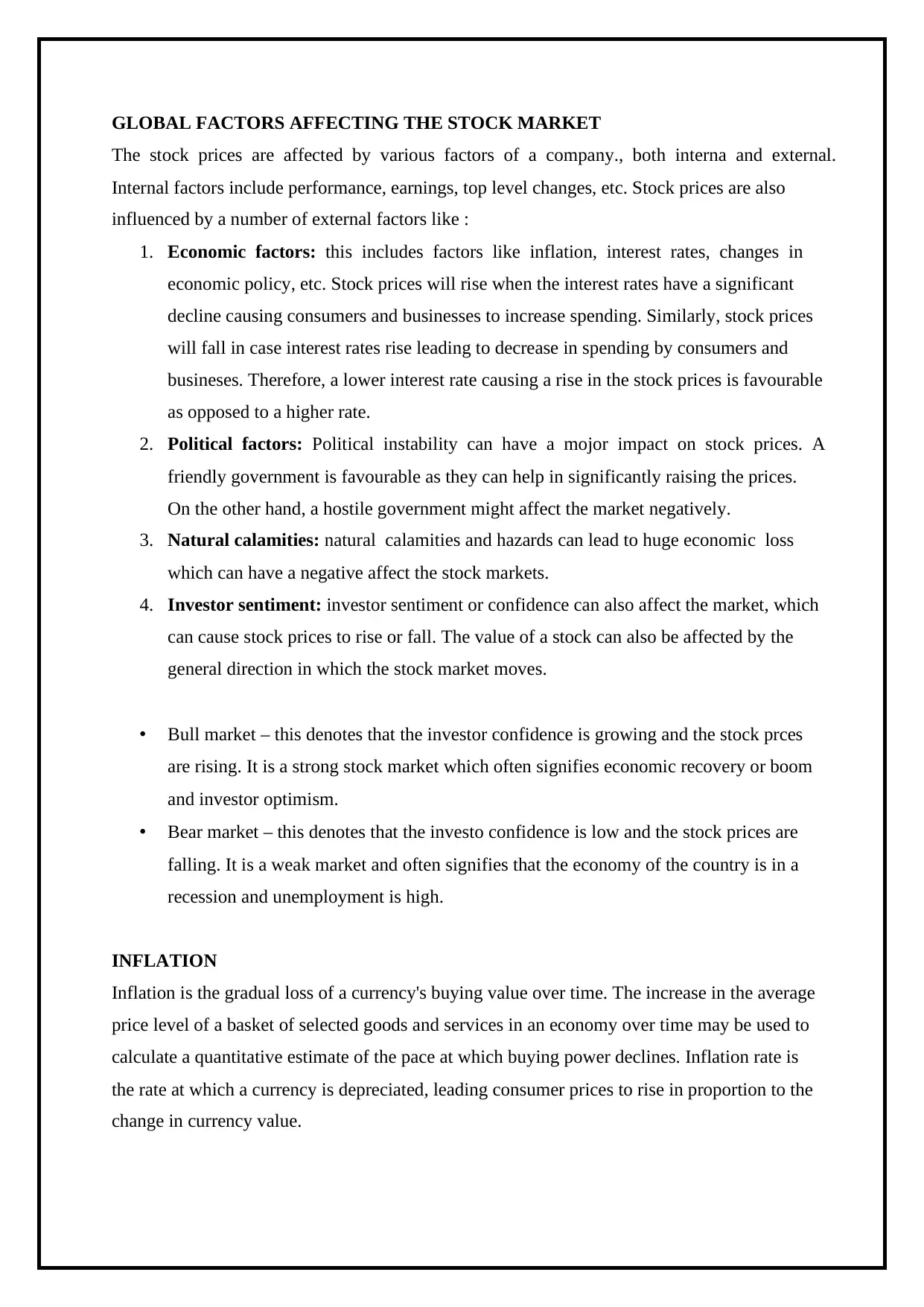
GLOBAL FACTORS AFFECTING THE STOCK MARKET
The stock prices are affected by various factors of a company., both interna and external.
Internal factors include performance, earnings, top level changes, etc. Stock prices are also
influenced by a number of external factors like :
1. Economic factors: this includes factors like inflation, interest rates, changes in
economic policy, etc. Stock prices will rise when the interest rates have a significant
decline causing consumers and businesses to increase spending. Similarly, stock prices
will fall in case interest rates rise leading to decrease in spending by consumers and
busineses. Therefore, a lower interest rate causing a rise in the stock prices is favourable
as opposed to a higher rate.
2. Political factors: Political instability can have a mojor impact on stock prices. A
friendly government is favourable as they can help in significantly raising the prices.
On the other hand, a hostile government might affect the market negatively.
3. Natural calamities: natural calamities and hazards can lead to huge economic loss
which can have a negative affect the stock markets.
4. Investor sentiment: investor sentiment or confidence can also affect the market, which
can cause stock prices to rise or fall. The value of a stock can also be affected by the
general direction in which the stock market moves.
• Bull market – this denotes that the investor confidence is growing and the stock prces
are rising. It is a strong stock market which often signifies economic recovery or boom
and investor optimism.
• Bear market – this denotes that the investo confidence is low and the stock prices are
falling. It is a weak market and often signifies that the economy of the country is in a
recession and unemployment is high.
INFLATION
Inflation is the gradual loss of a currency's buying value over time. The increase in the average
price level of a basket of selected goods and services in an economy over time may be used to
calculate a quantitative estimate of the pace at which buying power declines. Inflation rate is
the rate at which a currency is depreciated, leading consumer prices to rise in proportion to the
change in currency value.
The stock prices are affected by various factors of a company., both interna and external.
Internal factors include performance, earnings, top level changes, etc. Stock prices are also
influenced by a number of external factors like :
1. Economic factors: this includes factors like inflation, interest rates, changes in
economic policy, etc. Stock prices will rise when the interest rates have a significant
decline causing consumers and businesses to increase spending. Similarly, stock prices
will fall in case interest rates rise leading to decrease in spending by consumers and
busineses. Therefore, a lower interest rate causing a rise in the stock prices is favourable
as opposed to a higher rate.
2. Political factors: Political instability can have a mojor impact on stock prices. A
friendly government is favourable as they can help in significantly raising the prices.
On the other hand, a hostile government might affect the market negatively.
3. Natural calamities: natural calamities and hazards can lead to huge economic loss
which can have a negative affect the stock markets.
4. Investor sentiment: investor sentiment or confidence can also affect the market, which
can cause stock prices to rise or fall. The value of a stock can also be affected by the
general direction in which the stock market moves.
• Bull market – this denotes that the investor confidence is growing and the stock prces
are rising. It is a strong stock market which often signifies economic recovery or boom
and investor optimism.
• Bear market – this denotes that the investo confidence is low and the stock prices are
falling. It is a weak market and often signifies that the economy of the country is in a
recession and unemployment is high.
INFLATION
Inflation is the gradual loss of a currency's buying value over time. The increase in the average
price level of a basket of selected goods and services in an economy over time may be used to
calculate a quantitative estimate of the pace at which buying power declines. Inflation rate is
the rate at which a currency is depreciated, leading consumer prices to rise in proportion to the
change in currency value.
⊘ This is a preview!⊘
Do you want full access?
Subscribe today to unlock all pages.

Trusted by 1+ million students worldwide
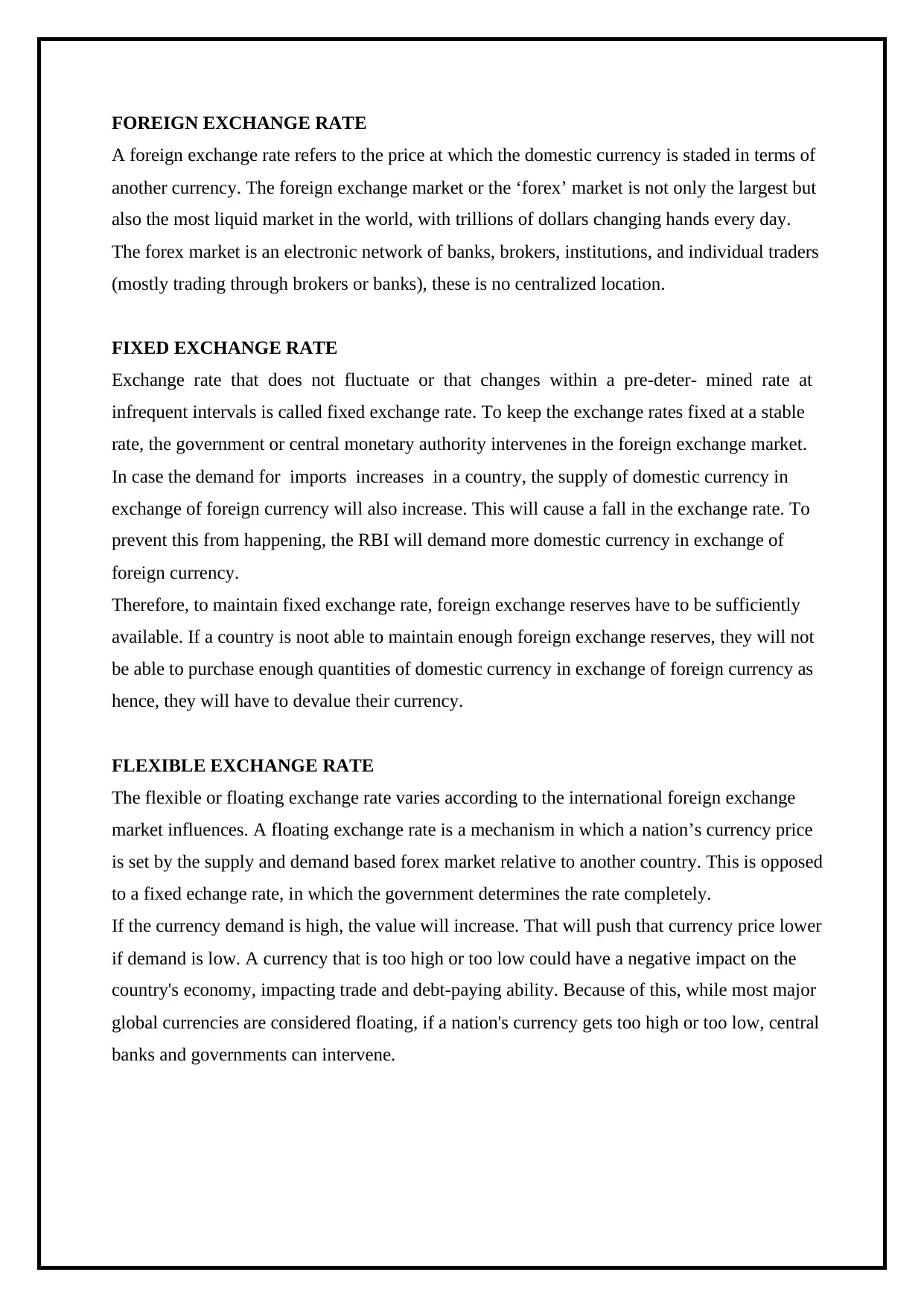
FOREIGN EXCHANGE RATE
A foreign exchange rate refers to the price at which the domestic currency is staded in terms of
another currency. The foreign exchange market or the ‘forex’ market is not only the largest but
also the most liquid market in the world, with trillions of dollars changing hands every day.
The forex market is an electronic network of banks, brokers, institutions, and individual traders
(mostly trading through brokers or banks), these is no centralized location.
FIXED EXCHANGE RATE
Exchange rate that does not fluctuate or that changes within a pre-deter- mined rate at
infrequent intervals is called fixed exchange rate. To keep the exchange rates fixed at a stable
rate, the government or central monetary authority intervenes in the foreign exchange market.
In case the demand for imports increases in a country, the supply of domestic currency in
exchange of foreign currency will also increase. This will cause a fall in the exchange rate. To
prevent this from happening, the RBI will demand more domestic currency in exchange of
foreign currency.
Therefore, to maintain fixed exchange rate, foreign exchange reserves have to be sufficiently
available. If a country is noot able to maintain enough foreign exchange reserves, they will not
be able to purchase enough quantities of domestic currency in exchange of foreign currency as
hence, they will have to devalue their currency.
FLEXIBLE EXCHANGE RATE
The flexible or floating exchange rate varies according to the international foreign exchange
market influences. A floating exchange rate is a mechanism in which a nation’s currency price
is set by the supply and demand based forex market relative to another country. This is opposed
to a fixed echange rate, in which the government determines the rate completely.
If the currency demand is high, the value will increase. That will push that currency price lower
if demand is low. A currency that is too high or too low could have a negative impact on the
country's economy, impacting trade and debt-paying ability. Because of this, while most major
global currencies are considered floating, if a nation's currency gets too high or too low, central
banks and governments can intervene.
A foreign exchange rate refers to the price at which the domestic currency is staded in terms of
another currency. The foreign exchange market or the ‘forex’ market is not only the largest but
also the most liquid market in the world, with trillions of dollars changing hands every day.
The forex market is an electronic network of banks, brokers, institutions, and individual traders
(mostly trading through brokers or banks), these is no centralized location.
FIXED EXCHANGE RATE
Exchange rate that does not fluctuate or that changes within a pre-deter- mined rate at
infrequent intervals is called fixed exchange rate. To keep the exchange rates fixed at a stable
rate, the government or central monetary authority intervenes in the foreign exchange market.
In case the demand for imports increases in a country, the supply of domestic currency in
exchange of foreign currency will also increase. This will cause a fall in the exchange rate. To
prevent this from happening, the RBI will demand more domestic currency in exchange of
foreign currency.
Therefore, to maintain fixed exchange rate, foreign exchange reserves have to be sufficiently
available. If a country is noot able to maintain enough foreign exchange reserves, they will not
be able to purchase enough quantities of domestic currency in exchange of foreign currency as
hence, they will have to devalue their currency.
FLEXIBLE EXCHANGE RATE
The flexible or floating exchange rate varies according to the international foreign exchange
market influences. A floating exchange rate is a mechanism in which a nation’s currency price
is set by the supply and demand based forex market relative to another country. This is opposed
to a fixed echange rate, in which the government determines the rate completely.
If the currency demand is high, the value will increase. That will push that currency price lower
if demand is low. A currency that is too high or too low could have a negative impact on the
country's economy, impacting trade and debt-paying ability. Because of this, while most major
global currencies are considered floating, if a nation's currency gets too high or too low, central
banks and governments can intervene.
Paraphrase This Document
Need a fresh take? Get an instant paraphrase of this document with our AI Paraphraser
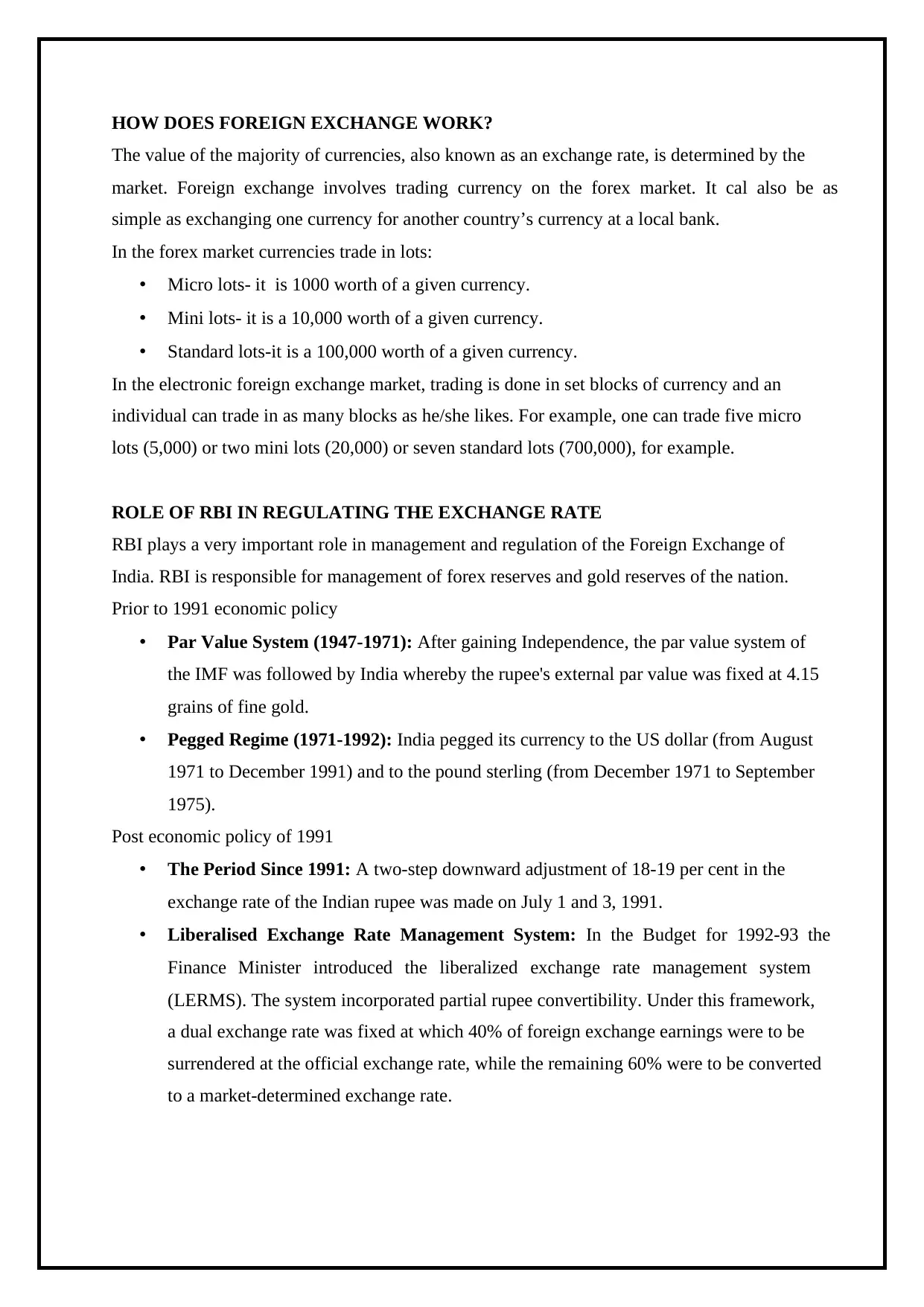
HOW DOES FOREIGN EXCHANGE WORK?
The value of the majority of currencies, also known as an exchange rate, is determined by the
market. Foreign exchange involves trading currency on the forex market. It cal also be as
simple as exchanging one currency for another country’s currency at a local bank.
In the forex market currencies trade in lots:
• Micro lots- it is 1000 worth of a given currency.
• Mini lots- it is a 10,000 worth of a given currency.
• Standard lots-it is a 100,000 worth of a given currency.
In the electronic foreign exchange market, trading is done in set blocks of currency and an
individual can trade in as many blocks as he/she likes. For example, one can trade five micro
lots (5,000) or two mini lots (20,000) or seven standard lots (700,000), for example.
ROLE OF RBI IN REGULATING THE EXCHANGE RATE
RBI plays a very important role in management and regulation of the Foreign Exchange of
India. RBI is responsible for management of forex reserves and gold reserves of the nation.
Prior to 1991 economic policy
• Par Value System (1947-1971): After gaining Independence, the par value system of
the IMF was followed by India whereby the rupee's external par value was fixed at 4.15
grains of fine gold.
• Pegged Regime (1971-1992): India pegged its currency to the US dollar (from August
1971 to December 1991) and to the pound sterling (from December 1971 to September
1975).
Post economic policy of 1991
• The Period Since 1991: A two-step downward adjustment of 18-19 per cent in the
exchange rate of the Indian rupee was made on July 1 and 3, 1991.
• Liberalised Exchange Rate Management System: In the Budget for 1992-93 the
Finance Minister introduced the liberalized exchange rate management system
(LERMS). The system incorporated partial rupee convertibility. Under this framework,
a dual exchange rate was fixed at which 40% of foreign exchange earnings were to be
surrendered at the official exchange rate, while the remaining 60% were to be converted
to a market-determined exchange rate.
The value of the majority of currencies, also known as an exchange rate, is determined by the
market. Foreign exchange involves trading currency on the forex market. It cal also be as
simple as exchanging one currency for another country’s currency at a local bank.
In the forex market currencies trade in lots:
• Micro lots- it is 1000 worth of a given currency.
• Mini lots- it is a 10,000 worth of a given currency.
• Standard lots-it is a 100,000 worth of a given currency.
In the electronic foreign exchange market, trading is done in set blocks of currency and an
individual can trade in as many blocks as he/she likes. For example, one can trade five micro
lots (5,000) or two mini lots (20,000) or seven standard lots (700,000), for example.
ROLE OF RBI IN REGULATING THE EXCHANGE RATE
RBI plays a very important role in management and regulation of the Foreign Exchange of
India. RBI is responsible for management of forex reserves and gold reserves of the nation.
Prior to 1991 economic policy
• Par Value System (1947-1971): After gaining Independence, the par value system of
the IMF was followed by India whereby the rupee's external par value was fixed at 4.15
grains of fine gold.
• Pegged Regime (1971-1992): India pegged its currency to the US dollar (from August
1971 to December 1991) and to the pound sterling (from December 1971 to September
1975).
Post economic policy of 1991
• The Period Since 1991: A two-step downward adjustment of 18-19 per cent in the
exchange rate of the Indian rupee was made on July 1 and 3, 1991.
• Liberalised Exchange Rate Management System: In the Budget for 1992-93 the
Finance Minister introduced the liberalized exchange rate management system
(LERMS). The system incorporated partial rupee convertibility. Under this framework,
a dual exchange rate was fixed at which 40% of foreign exchange earnings were to be
surrendered at the official exchange rate, while the remaining 60% were to be converted
to a market-determined exchange rate.
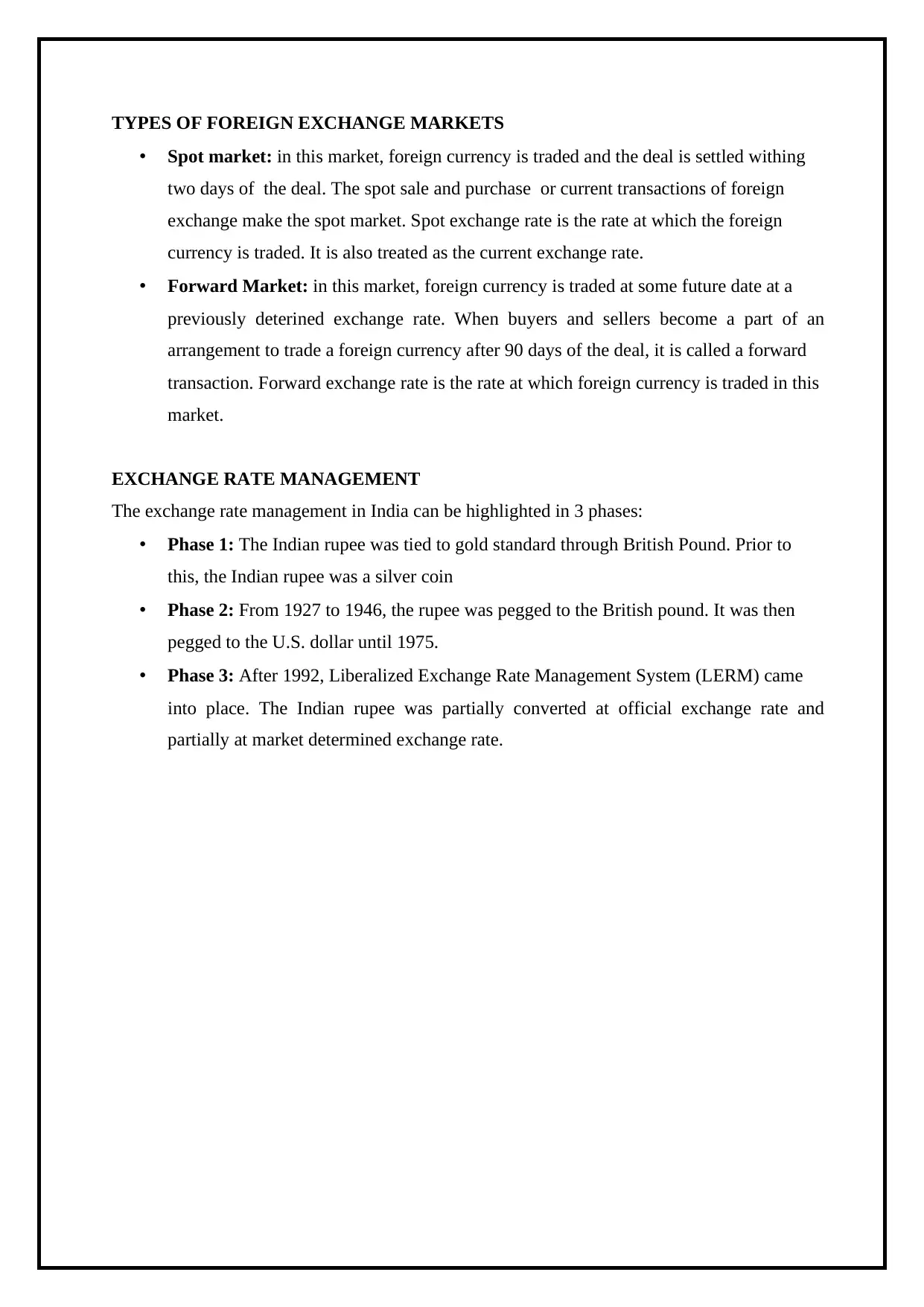
TYPES OF FOREIGN EXCHANGE MARKETS
• Spot market: in this market, foreign currency is traded and the deal is settled withing
two days of the deal. The spot sale and purchase or current transactions of foreign
exchange make the spot market. Spot exchange rate is the rate at which the foreign
currency is traded. It is also treated as the current exchange rate.
• Forward Market: in this market, foreign currency is traded at some future date at a
previously deterined exchange rate. When buyers and sellers become a part of an
arrangement to trade a foreign currency after 90 days of the deal, it is called a forward
transaction. Forward exchange rate is the rate at which foreign currency is traded in this
market.
EXCHANGE RATE MANAGEMENT
The exchange rate management in India can be highlighted in 3 phases:
• Phase 1: The Indian rupee was tied to gold standard through British Pound. Prior to
this, the Indian rupee was a silver coin
• Phase 2: From 1927 to 1946, the rupee was pegged to the British pound. It was then
pegged to the U.S. dollar until 1975.
• Phase 3: After 1992, Liberalized Exchange Rate Management System (LERM) came
into place. The Indian rupee was partially converted at official exchange rate and
partially at market determined exchange rate.
• Spot market: in this market, foreign currency is traded and the deal is settled withing
two days of the deal. The spot sale and purchase or current transactions of foreign
exchange make the spot market. Spot exchange rate is the rate at which the foreign
currency is traded. It is also treated as the current exchange rate.
• Forward Market: in this market, foreign currency is traded at some future date at a
previously deterined exchange rate. When buyers and sellers become a part of an
arrangement to trade a foreign currency after 90 days of the deal, it is called a forward
transaction. Forward exchange rate is the rate at which foreign currency is traded in this
market.
EXCHANGE RATE MANAGEMENT
The exchange rate management in India can be highlighted in 3 phases:
• Phase 1: The Indian rupee was tied to gold standard through British Pound. Prior to
this, the Indian rupee was a silver coin
• Phase 2: From 1927 to 1946, the rupee was pegged to the British pound. It was then
pegged to the U.S. dollar until 1975.
• Phase 3: After 1992, Liberalized Exchange Rate Management System (LERM) came
into place. The Indian rupee was partially converted at official exchange rate and
partially at market determined exchange rate.
⊘ This is a preview!⊘
Do you want full access?
Subscribe today to unlock all pages.

Trusted by 1+ million students worldwide
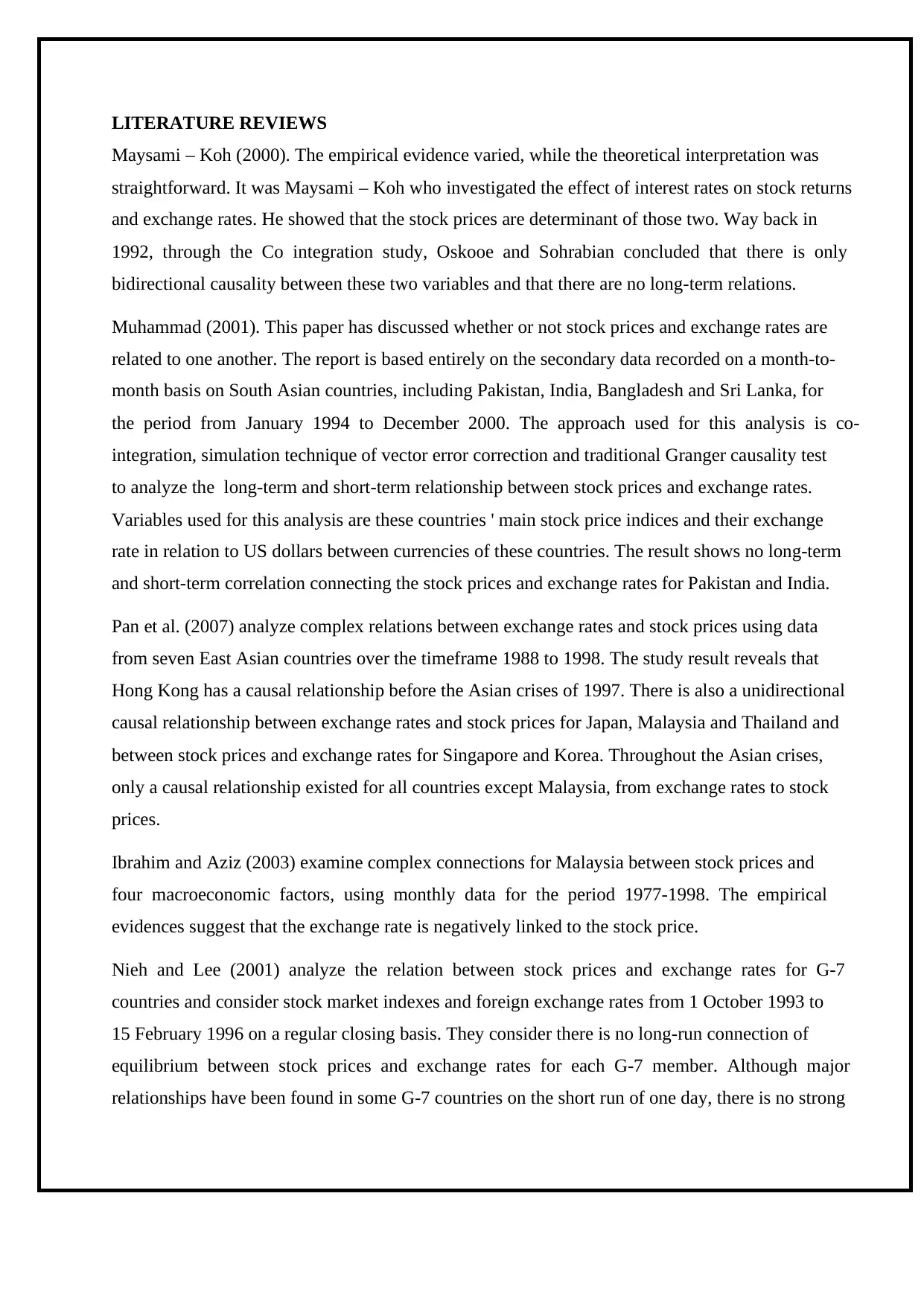
LITERATURE REVIEWS
Maysami – Koh (2000). The empirical evidence varied, while the theoretical interpretation was
straightforward. It was Maysami – Koh who investigated the effect of interest rates on stock returns
and exchange rates. He showed that the stock prices are determinant of those two. Way back in
1992, through the Co integration study, Oskooe and Sohrabian concluded that there is only
bidirectional causality between these two variables and that there are no long-term relations.
Muhammad (2001). This paper has discussed whether or not stock prices and exchange rates are
related to one another. The report is based entirely on the secondary data recorded on a month-to-
month basis on South Asian countries, including Pakistan, India, Bangladesh and Sri Lanka, for
the period from January 1994 to December 2000. The approach used for this analysis is co-
integration, simulation technique of vector error correction and traditional Granger causality test
to analyze the long-term and short-term relationship between stock prices and exchange rates.
Variables used for this analysis are these countries ' main stock price indices and their exchange
rate in relation to US dollars between currencies of these countries. The result shows no long-term
and short-term correlation connecting the stock prices and exchange rates for Pakistan and India.
Pan et al. (2007) analyze complex relations between exchange rates and stock prices using data
from seven East Asian countries over the timeframe 1988 to 1998. The study result reveals that
Hong Kong has a causal relationship before the Asian crises of 1997. There is also a unidirectional
causal relationship between exchange rates and stock prices for Japan, Malaysia and Thailand and
between stock prices and exchange rates for Singapore and Korea. Throughout the Asian crises,
only a causal relationship existed for all countries except Malaysia, from exchange rates to stock
prices.
Ibrahim and Aziz (2003) examine complex connections for Malaysia between stock prices and
four macroeconomic factors, using monthly data for the period 1977-1998. The empirical
evidences suggest that the exchange rate is negatively linked to the stock price.
Nieh and Lee (2001) analyze the relation between stock prices and exchange rates for G-7
countries and consider stock market indexes and foreign exchange rates from 1 October 1993 to
15 February 1996 on a regular closing basis. They consider there is no long-run connection of
equilibrium between stock prices and exchange rates for each G-7 member. Although major
relationships have been found in some G-7 countries on the short run of one day, there is no strong
Maysami – Koh (2000). The empirical evidence varied, while the theoretical interpretation was
straightforward. It was Maysami – Koh who investigated the effect of interest rates on stock returns
and exchange rates. He showed that the stock prices are determinant of those two. Way back in
1992, through the Co integration study, Oskooe and Sohrabian concluded that there is only
bidirectional causality between these two variables and that there are no long-term relations.
Muhammad (2001). This paper has discussed whether or not stock prices and exchange rates are
related to one another. The report is based entirely on the secondary data recorded on a month-to-
month basis on South Asian countries, including Pakistan, India, Bangladesh and Sri Lanka, for
the period from January 1994 to December 2000. The approach used for this analysis is co-
integration, simulation technique of vector error correction and traditional Granger causality test
to analyze the long-term and short-term relationship between stock prices and exchange rates.
Variables used for this analysis are these countries ' main stock price indices and their exchange
rate in relation to US dollars between currencies of these countries. The result shows no long-term
and short-term correlation connecting the stock prices and exchange rates for Pakistan and India.
Pan et al. (2007) analyze complex relations between exchange rates and stock prices using data
from seven East Asian countries over the timeframe 1988 to 1998. The study result reveals that
Hong Kong has a causal relationship before the Asian crises of 1997. There is also a unidirectional
causal relationship between exchange rates and stock prices for Japan, Malaysia and Thailand and
between stock prices and exchange rates for Singapore and Korea. Throughout the Asian crises,
only a causal relationship existed for all countries except Malaysia, from exchange rates to stock
prices.
Ibrahim and Aziz (2003) examine complex connections for Malaysia between stock prices and
four macroeconomic factors, using monthly data for the period 1977-1998. The empirical
evidences suggest that the exchange rate is negatively linked to the stock price.
Nieh and Lee (2001) analyze the relation between stock prices and exchange rates for G-7
countries and consider stock market indexes and foreign exchange rates from 1 October 1993 to
15 February 1996 on a regular closing basis. They consider there is no long-run connection of
equilibrium between stock prices and exchange rates for each G-7 member. Although major
relationships have been found in some G-7 countries on the short run of one day, there is no strong
Paraphrase This Document
Need a fresh take? Get an instant paraphrase of this document with our AI Paraphraser
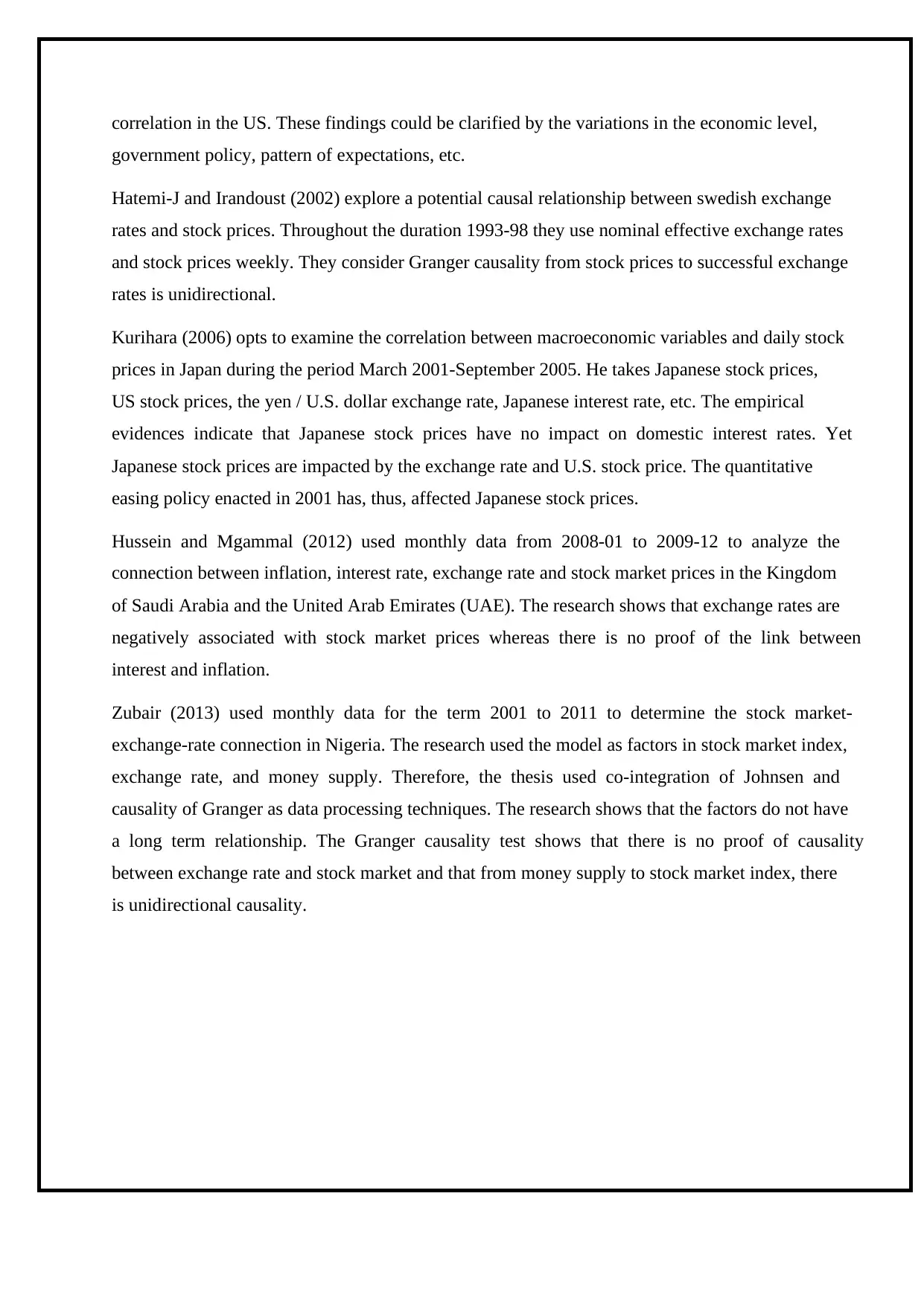
correlation in the US. These findings could be clarified by the variations in the economic level,
government policy, pattern of expectations, etc.
Hatemi-J and Irandoust (2002) explore a potential causal relationship between swedish exchange
rates and stock prices. Throughout the duration 1993-98 they use nominal effective exchange rates
and stock prices weekly. They consider Granger causality from stock prices to successful exchange
rates is unidirectional.
Kurihara (2006) opts to examine the correlation between macroeconomic variables and daily stock
prices in Japan during the period March 2001-September 2005. He takes Japanese stock prices,
US stock prices, the yen / U.S. dollar exchange rate, Japanese interest rate, etc. The empirical
evidences indicate that Japanese stock prices have no impact on domestic interest rates. Yet
Japanese stock prices are impacted by the exchange rate and U.S. stock price. The quantitative
easing policy enacted in 2001 has, thus, affected Japanese stock prices.
Hussein and Mgammal (2012) used monthly data from 2008-01 to 2009-12 to analyze the
connection between inflation, interest rate, exchange rate and stock market prices in the Kingdom
of Saudi Arabia and the United Arab Emirates (UAE). The research shows that exchange rates are
negatively associated with stock market prices whereas there is no proof of the link between
interest and inflation.
Zubair (2013) used monthly data for the term 2001 to 2011 to determine the stock market-
exchange-rate connection in Nigeria. The research used the model as factors in stock market index,
exchange rate, and money supply. Therefore, the thesis used co-integration of Johnsen and
causality of Granger as data processing techniques. The research shows that the factors do not have
a long term relationship. The Granger causality test shows that there is no proof of causality
between exchange rate and stock market and that from money supply to stock market index, there
is unidirectional causality.
government policy, pattern of expectations, etc.
Hatemi-J and Irandoust (2002) explore a potential causal relationship between swedish exchange
rates and stock prices. Throughout the duration 1993-98 they use nominal effective exchange rates
and stock prices weekly. They consider Granger causality from stock prices to successful exchange
rates is unidirectional.
Kurihara (2006) opts to examine the correlation between macroeconomic variables and daily stock
prices in Japan during the period March 2001-September 2005. He takes Japanese stock prices,
US stock prices, the yen / U.S. dollar exchange rate, Japanese interest rate, etc. The empirical
evidences indicate that Japanese stock prices have no impact on domestic interest rates. Yet
Japanese stock prices are impacted by the exchange rate and U.S. stock price. The quantitative
easing policy enacted in 2001 has, thus, affected Japanese stock prices.
Hussein and Mgammal (2012) used monthly data from 2008-01 to 2009-12 to analyze the
connection between inflation, interest rate, exchange rate and stock market prices in the Kingdom
of Saudi Arabia and the United Arab Emirates (UAE). The research shows that exchange rates are
negatively associated with stock market prices whereas there is no proof of the link between
interest and inflation.
Zubair (2013) used monthly data for the term 2001 to 2011 to determine the stock market-
exchange-rate connection in Nigeria. The research used the model as factors in stock market index,
exchange rate, and money supply. Therefore, the thesis used co-integration of Johnsen and
causality of Granger as data processing techniques. The research shows that the factors do not have
a long term relationship. The Granger causality test shows that there is no proof of causality
between exchange rate and stock market and that from money supply to stock market index, there
is unidirectional causality.
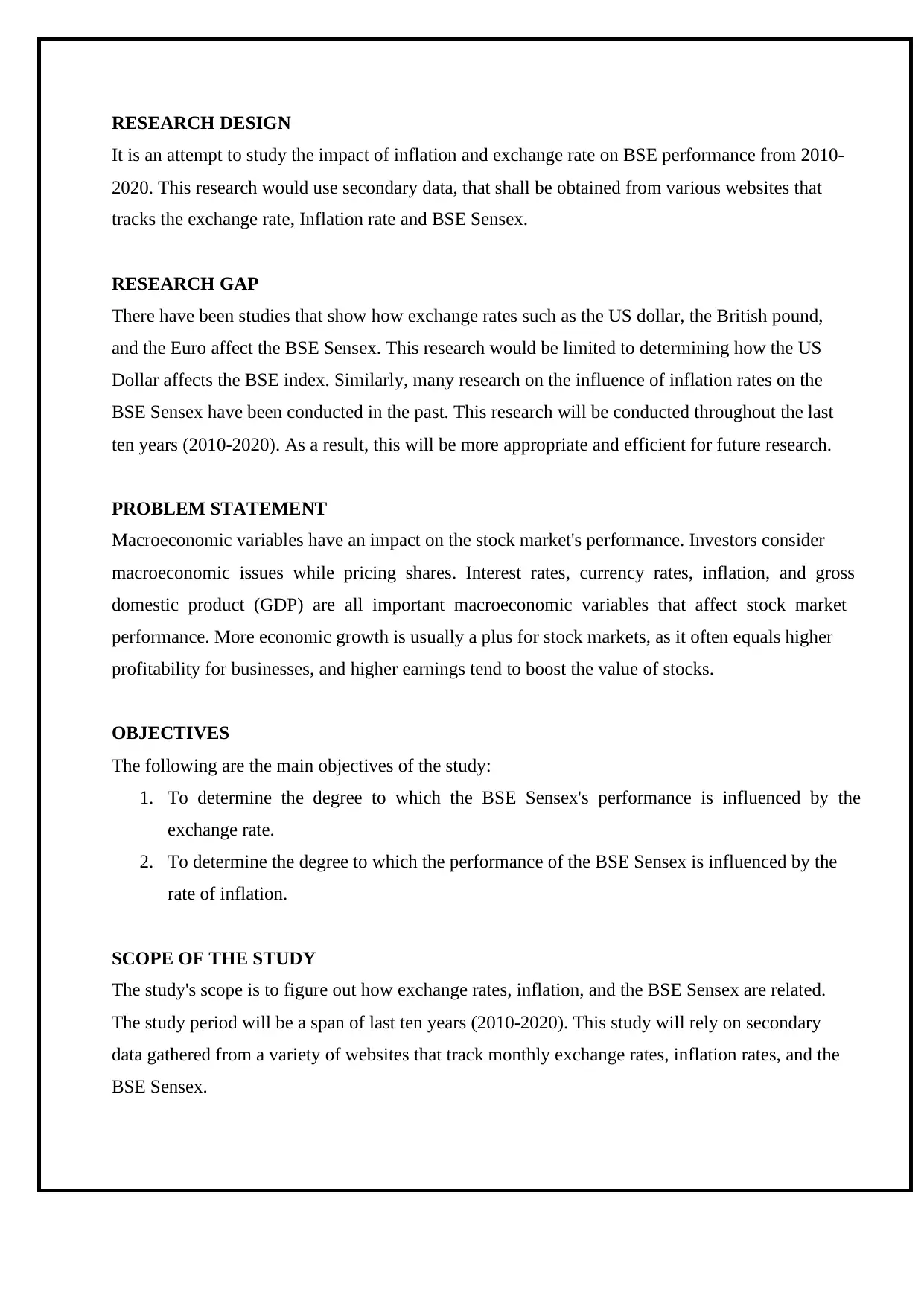
RESEARCH DESIGN
It is an attempt to study the impact of inflation and exchange rate on BSE performance from 2010-
2020. This research would use secondary data, that shall be obtained from various websites that
tracks the exchange rate, Inflation rate and BSE Sensex.
RESEARCH GAP
There have been studies that show how exchange rates such as the US dollar, the British pound,
and the Euro affect the BSE Sensex. This research would be limited to determining how the US
Dollar affects the BSE index. Similarly, many research on the influence of inflation rates on the
BSE Sensex have been conducted in the past. This research will be conducted throughout the last
ten years (2010-2020). As a result, this will be more appropriate and efficient for future research.
PROBLEM STATEMENT
Macroeconomic variables have an impact on the stock market's performance. Investors consider
macroeconomic issues while pricing shares. Interest rates, currency rates, inflation, and gross
domestic product (GDP) are all important macroeconomic variables that affect stock market
performance. More economic growth is usually a plus for stock markets, as it often equals higher
profitability for businesses, and higher earnings tend to boost the value of stocks.
OBJECTIVES
The following are the main objectives of the study:
1. To determine the degree to which the BSE Sensex's performance is influenced by the
exchange rate.
2. To determine the degree to which the performance of the BSE Sensex is influenced by the
rate of inflation.
SCOPE OF THE STUDY
The study's scope is to figure out how exchange rates, inflation, and the BSE Sensex are related.
The study period will be a span of last ten years (2010-2020). This study will rely on secondary
data gathered from a variety of websites that track monthly exchange rates, inflation rates, and the
BSE Sensex.
It is an attempt to study the impact of inflation and exchange rate on BSE performance from 2010-
2020. This research would use secondary data, that shall be obtained from various websites that
tracks the exchange rate, Inflation rate and BSE Sensex.
RESEARCH GAP
There have been studies that show how exchange rates such as the US dollar, the British pound,
and the Euro affect the BSE Sensex. This research would be limited to determining how the US
Dollar affects the BSE index. Similarly, many research on the influence of inflation rates on the
BSE Sensex have been conducted in the past. This research will be conducted throughout the last
ten years (2010-2020). As a result, this will be more appropriate and efficient for future research.
PROBLEM STATEMENT
Macroeconomic variables have an impact on the stock market's performance. Investors consider
macroeconomic issues while pricing shares. Interest rates, currency rates, inflation, and gross
domestic product (GDP) are all important macroeconomic variables that affect stock market
performance. More economic growth is usually a plus for stock markets, as it often equals higher
profitability for businesses, and higher earnings tend to boost the value of stocks.
OBJECTIVES
The following are the main objectives of the study:
1. To determine the degree to which the BSE Sensex's performance is influenced by the
exchange rate.
2. To determine the degree to which the performance of the BSE Sensex is influenced by the
rate of inflation.
SCOPE OF THE STUDY
The study's scope is to figure out how exchange rates, inflation, and the BSE Sensex are related.
The study period will be a span of last ten years (2010-2020). This study will rely on secondary
data gathered from a variety of websites that track monthly exchange rates, inflation rates, and the
BSE Sensex.
⊘ This is a preview!⊘
Do you want full access?
Subscribe today to unlock all pages.

Trusted by 1+ million students worldwide
1 out of 25
Related Documents
Your All-in-One AI-Powered Toolkit for Academic Success.
+13062052269
info@desklib.com
Available 24*7 on WhatsApp / Email
![[object Object]](/_next/static/media/star-bottom.7253800d.svg)
Unlock your academic potential
Copyright © 2020–2025 A2Z Services. All Rights Reserved. Developed and managed by ZUCOL.





